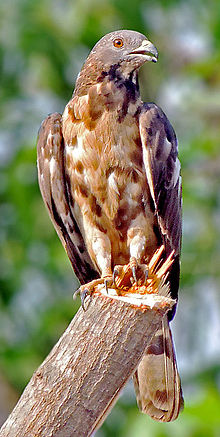Crested honey buzzard
| Crested honey buzzard | |
|---|---|

| |
| Scientific classification | |
| Kingdom: | Animalia |
| Phylum: | Chordata |
| Class: | Aves |
| Order: | Accipitriformes |
| Family: | Accipitridae |
| Genus: | Pernis |
| Species: | P. ptilorhynchus
|
| Binomial name | |
| Pernis ptilorhynchus (Temminck, 1821)
| |
| Synonyms | |
| |
The crested honey buzzard (Pernis ptilorhynchus)[3] is a bird of prey in the family Accipitridae, which also includes many other diurnal raptors such as kites, eagles, and harriers. This species is also known as the Oriental honey buzzard.
Description[]

Despite its name, this species is not related to Buteo buzzards, and is taxonomically closer to the kites.[4] It appears long-necked with a small head (resembling that of a pigeon), and soars on flat wings. The head lacks a strong superciliary ridge, giving it a facial appearance very unlike a raptor. It has a long tail and a short head crest. It is brown above, but not as dark as European honey buzzard, and paler below. A dark throat stripe is present. Unusually for a large bird of prey, the sexes can be distinguished. The male has a blue-grey head, while the female's head is brown. She is slightly larger and darker than the male. The male has a black tail with a white band.
It breeds in Asia from central Siberia east to Japan. It is a summer migrant to Siberia, wintering in tropical Southeast Asia. Elsewhere, it is more-or-less resident. It is a specialist feeder, living mainly on the larvae of social bees and wasps, and eating bits of comb and honey;[5] it takes other small insect prey such as cicadas.[6]
The crested honey buzzard breeds in woodland, and is inconspicuous except in the spring, when the mating display includes wing-clapping. The display of roller-coasting in flight and fluttering wings at the peak of the ascent are characteristic of the genus Pernis.[7][8]
The similarity in plumage between juvenile crested honey buzzards and the Nisaetus hawk-eagles may have arisen as a partial protection against predation by larger raptors. The eagles have stronger bills and talons, and are likely to be less vulnerable than the Pernis species. Similar mimicry is shown by the juveniles of the European honey buzzard, which resembles the common buzzard. Although the northern goshawk is capable of killing both species, it is likely to be more cautious about attacking the better protected Buteo species.
Distribution and habitat[]
Crested buzzards that migrate from breeding areas in Japan to wintering areas in Southeast Asia fly over the East China Sea. This 700-km nonstop flight over water is possible because during autumn, winds over the sea blow in the same direction as the birds' direction of flight (i.e. wind support).[9] As climate change affects wind conditions worldwide, the wind support over the East China Sea could be reduced.[10]
Taxonomy[]

Pernis ptilorhynchus includes the following subspecies:[11]
- P. p. orientalis - Taczanowski, 1891
- P. p. ruficollis - Lesson, R, 1830
- P. p. torquatus - Lesson, R, 1830
- P. p. ptilorhynchus - (Temminck, 1821)
- P. p. palawanensis - Stresemann, 1940
- P. p. philippensis - Mayr, 1939
References[]
- ^ BirdLife International (2016). "Pernis ptilorhynchus". IUCN Red List of Threatened Species. 2016: e.T22694995A93483912. Retrieved 24 October 2021.
- ^ Dickinson, Edward C. (2012). "The first twenty livraisons of Les Planches Coloriées d'Oiseaux of Temminck & Laugier (1820–1839): IV. Discovery of the remaining wrappers". Zoological Bibliography. 2 (1): 34–49.
- ^ "Pernis ptilorhynchus (Crested Honey Buzzard)". Integrated Taxonomic Information System. Retrieved 15 May 2016.
- ^ Finlayson, Clive (2011). Avian Survivors: The History and Biogeography of Palearctic Birds. London, UK: T & AD Poyser. pp. 121–132. ISBN 978-0-7136-8865-8.
- ^ "Oriental Honey-buzzard (Pernis ptilorhynchus)".
- ^ Brues, Charles T. (1950). "Large Raptorial Birds as Enemies of Cicadas" (PDF). Psyche. 57 (2): 74–76. doi:10.1155/1950/49542.
- ^ James Ferguson-Lees; David A. Christie; Kim Franklin; Philip Burton; David Mead (2001). Raptors of the World: An Identification Guide to the Birds of Prey of the World. HMCo Field Guides. ISBN 978-0-618-12762-7.
- ^ Gewers, G.; Curio, E.; Hembra, S. H. (2006). "First observation of an advertisement display flight of 'Steere's Honey-buzzard' Pernis (celebensis) steerei on Panay, Philippines" (PDF). Forktail. 22: 163–165. Archived from the original (PDF) on 2012-02-26.
- ^ Nourani, Elham; Yamaguchi, Noriyuki M; Manda, Atsuyoshi; Higuchi, Hiroyoshi (2016). "Wind conditions facilitate the seasonal water-crossing behaviour of Oriental Honey-buzzards Pernis ptilorhynchus over the East China Sea". Ibis. 158 (3): 506–518. doi:10.1111/ibi.12383.
- ^ Nourani, Elham; Yamaguchi, Noriyuki M; Higuchi, Hiroyoshi (2017). "Climate change alters the optimal wind-dependent flight routes of an avian migrant". Proceedings of the Royal Society B. 284 (1854): 20170149. doi:10.1098/rspb.2017.0149. PMC 5443942. PMID 28469028.
- ^ Gill F, D Donsker & P Rasmussen (Eds). 2020. IOC World Bird List (v10.2). doi : 10.14344/IOC.ML.10.2.
External links[]
| Wikimedia Commons has media related to Pernis ptilorhynchus. |
| Wikispecies has information related to Pernis ptilorhynchus. |
- IUCN Red List least concern species
- Pernis (bird)
- Birds of prey of Asia
- Birds of Manchuria
- Birds of Korea
- Birds of Japan
- Birds of Central China
- Birds of South Asia
- Birds of Bangladesh
- Birds of Southeast Asia
- Birds described in 1821
